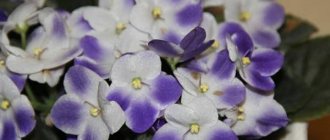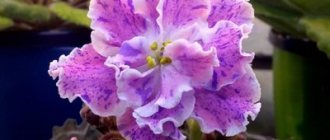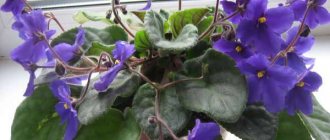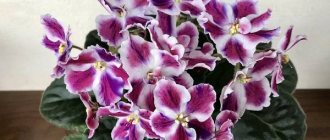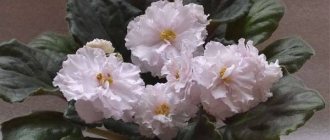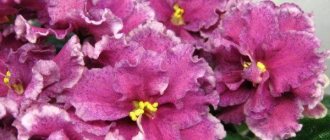Often a similar name is given to different varieties that were bred by different breeders. Often such Saintpaulias are called a series, especially if they have similar features.
Rococo is a wonderful period in art that inspires contemporaries, including breeders who use this name for new varieties. In this article we will look at the varieties of violets Rococo Rose, Rococo Ballet, Rococo Pink, RS-Rococo, Rococo Viol.
Description of indoor violet
House violet, or Saintpaulia, is a herbaceous flowering plant, usually perennial, whose bush is characterized by short stature and the absence of a central stem. Dense leaves are united into a basal rosette. They have an oval oblong shape and jagged edges. Their green color can be either light or dark. Representatives of some varieties are characterized by leaves with an unusual spotted pattern.
Saintpaulia flowers are formed in the central part of the rosette and are single. Depending on the variety, they have different shapes and colors. There are, for example, semi-double, terry, fringed. Homemade violets are distinguished by a variety of colors: white, pink, red, blue, purple. The colors can be either plain or combined or patterned, for example, with a speck or a border.
With proper care, the flowering period can last up to ten months. As a result of flowering, a fruit appears, which is a box with small seeds that are suitable for sowing for two years.
Popular varieties
Indoor violet is a great success among lovers of house plants. Many flower growers are creating collections showcasing the wide variety of varieties of this species. Today there are more than 32,000 of them.
Here are some of the most famous:
- Mars. Plants of this variety have large semi-double red flowers with a wide “frill” resembling lace. The edges of the petals are limited by a white border.
- Rosemary. The bushes of these violets are decorated with bright double flowers that look like stars. The petals are distinguished by corrugated edges and an unusual color with characteristic blue splashes on a pink background.
- Fire moths. Representatives of this variety are distinguished by bright red or burgundy flowers, which can be simple or semi-double in shape. The petals have corrugated edges with a white border.
- Rococo Viol. These Saintpaulias have double flowers of a dark blue, almost inky color, which resemble balls and look impressive against the background of light green foliage.
- Rococo Rose. Plants of this variety are distinguished by double bright pink flowers, similar to roses. Rococo Rose violets are similar to representatives of Rococo Viol.
- Flamenco. The variety is characterized by semi-double lilac-raspberry flowers with greenish-golden fringe and a bright yellow center. The presence of a green “ruffle” on the flower is a distinctive feature of these violets.
Violet RS-Rococo
RS-Rococo is an Uzambara violet, a genus of hybrid Saintpaulias, of the Gesneriev family.
The bush is of standard size, slightly spreading. This variety was developed in 2015 by breeder S. Repkina.
The leaves are light green, slightly curled, the cuttings are long and thick. The leaves are round in shape and have a slight waviness along the edge.
The flowers are large, with a strongly corrugated edge , several flowers on a peduncle, often blooming in a bouquet or a cap. The color of the flowers is white, the edges are dark crimson, with a rare golden-green ruffle.
Care and maintenance
In terms of care, this variety is no different from others, but the color of the flowers and their size may change depending on some factors:
- Lighting – bright, without direct rays;
- Watering – both classic and wick types of watering are equally suitable for this variety; the systematicity of watering and fertilizing is similar to other varieties. The less nutrients there are in the water, the smaller the flowers become;
- Soil - a mixture of peat with soil and perlite, as well as with the addition of half a part of moss or coconut fiber, is suitable for classic watering. For wick, it is recommended to take only peat and perlite in equal parts;
- The temperature should be between 16-24°, according to the season. The color of PC-Rococo flowers also depends on the temperature; if it is too low during flowering, the proportion of dark parts will decrease.
Important! The abundance of lighting greatly affects the color of the flowers - the more and brighter the light, the darker the flowers, and in more shaded places the proportion of dark crimson color decreases, or it turns into pink.
Reviews
Alexander. “The rosette is spreading, quite large, the leaves are a little stretchy. The first flowering was very sparse, but the flowers are beautiful and large.”
Hope. “Very dissatisfied with this variety. The flowers are of course large and beautiful, but the rosette is quite loose and spreading, the cuttings of the leaves are long and rather thin. Maybe the problem is my care, but other varieties grow well and the rosettes are beautiful, especially considering that I keep it under lamps.”
Planting at home
The process of planting indoor violets is an important point that determines the quality of its further growth and flowering. The correct choice of planting material is of great importance.
Material selection
For this purpose, you should purchase a young plant in a pot or a leaf cutting, using the services of a specialized store or the suggestion of friends. You should not make a purchase on a spontaneous market at the risk of receiving an unsuitable product.
When choosing, you must consider a number of basic rules:
- The leaves of the plant should have a natural light green color, without any spots.
- If the leaf cutting is very elongated, this may indicate weakening of the planting material as a result of insufficient lighting.
- The rosette of the plant should not be very tight, as this is one of the signs of a characteristic disease.
- It should be noted that purchasing cuttings makes it possible to obtain several plants at the same time.
- It is advisable to make the selection in the spring, since in winter and summer it may be difficult to determine the condition of the roots due to their likely freezing or drying out.
Preparing the container and soil
To plant violets at home, you must first choose the right container and prepare the soil. The size of the pot is of great importance. It must be borne in mind that indoor violet begins to bloom only when its roots completely fill the surrounding space. Therefore, you should not choose a pot that is too large. It should be approximately two to three times smaller than the diameter of the outlet.
Soil specifically intended for Saintpaulia can be purchased at a specialty store or prepared independently. It should be light, breathable and have nutritional properties. Neutral or slightly acidic soil is suitable for violets.
To prepare the soil mixture, the following composition is recommended:
- leaf soil - 5 parts;
- peat – 3 parts;
- river sand – 1 part.
Experts advise adding perlite and vermiculite to the soil to improve its ability to retain moisture. Drainage is placed at the bottom of the pot (about 1/3 of the volume). Its role can be charcoal or small expanded clay.
Soil or water use
Planting using leaf cuttings can be done in two ways: immediately placing it in the ground or initially rooting it in water.
When planting in the soil, you must do the following:
- Trim the leaf so that the length of the stem is no more than 1/3 of the size of the plant.
- Prepare the soil. For planting, use a container whose diameter does not exceed 5 cm, for example, a regular plastic yogurt cup. First lay the drainage, then the soil.
- Make a small depression on the surface of the soil and fill it with finely chopped moss, which will secure the leaf and at the same time give it the opportunity to take root.
- Sprinkle the planted stem with soil, lightly water it with warm boiled water and cover it with a plastic bag to create greenhouse conditions.
- Carefully monitor the temperature level in the room, which should correspond to 22–25 degrees.
- Water the soil as it dries.
Caring for violets
In order for these wonderful plants to take root well at home and bloom for a long time, you need to carefully study all the necessary information about violets and caring for them. For the harmonious growth of Saintpaulia, the following factors are of great importance:
- Temperature conditions. The optimal temperature for growing is 20–22 degrees. The plant does not tolerate sudden changes in temperature and also needs protection from drafts.
- Lighting. Despite the fact that the indoor violet flower loves a lot of light, direct sunlight is contraindicated for it. If there is a lack of natural light, as well as in winter, when the length of daylight hours is reduced, it is worth using a fluorescent lamp.
- Air humidity. The required level is quite high - about 50%. To humidify the air in the room, you can use a basin of water or a wet towel placed on the radiator.
- Watering. This procedure requires a lot of attention. Both excess and lack of moisture are dangerous for violets. Watering should be done moderately, about 2 times a week, with warm and settled water. It is recommended to pour water into the pan, draining the remaining liquid after 30 minutes. The flower should not be sprayed, nor should water accidentally get on its outer parts.
- Feeding. It is an important component of Saintpaulia care, because for good growth and full flowering the plant needs sufficient macro- and microelements, as well as vitamins and amino acids. Fertilizers designed specifically for domestic violets are used. Feeding is carried out once every 2 weeks. But there are a number of restrictions. Fertilizers should not be introduced within a month after transplanting the plant, if it is weakened as a result of illness, or with a sharp change in air temperature.
- Transfer. This procedure is recommended to be carried out annually at any time except during the flowering period. Replanting is accompanied by a complete or partial replacement of the soil, and can also be carried out by transshipment. Complete soil replacement is used mainly for mature plants. With this method, the root system is almost completely cleared of soil. Replanting with partial soil replacement is suitable for young violets. With this method, only the soil that crumbles on its own is removed. The most gentle method is transshipment, when the plant is transplanted into a larger pot along with a lump of earth.
The basic requirements for caring for indoor violets can be supplemented with a few more simple recommendations, according to which it is necessary:
- periodically rotate the plant to ensure even exposure to light in order to obtain a beautiful, symmetrical bush;
- regularly clean the outlet from old leaves;
- remove faded flowers in a timely manner, stimulating the growth of new ones.
Violet Rococo Viol
Rococo Viol is an Uzambara violet, a genus of hybrid Saintpaulias, of the Gesneriev family. Semi-miniature bush, industrial , the name of the breeder remains unknown.
Girl leaves are very juicy, deep green in color with a pronounced depression near the base, which has a light green color. The shape of the leaves is round, slightly wavy along the edges, and slightly lighter at the ends.
Despite the distinct semi-mini size, in some cases this variety can grow to standards. The leaves are so powerful that the pot often needs to be secured to prevent it from falling.
The flowers are medium in size, collected in bouquets of 5-7 pieces, double flowers that look like small roses. The color of the flowers is very rich, bright ink color. Flowering is rare, usually with a small cap. Peduncles are tall and persistent.
Important! During reproduction, it is very pleasing to see the abundance of educated children, and stepsons often appear on the bush itself.
Care and maintenance
This variety is not picky and does not require special treatment; if you provide it with certain conditions, it will grow strong and fully reveal its beauty:
- The lighting should be bright, but without direct sun. This variety loves to twist its leaves and grow asymmetrically, so it is recommended to place it under lamps and not on the windowsill;
- The temperature , as for all violets, is maintained within 16-24°. In winter or during the dormant period it is lower, and in summer and during flowering it is slightly higher;
- Watering and fertilizing are carried out using classical methods (in a tray or on the ground) and using wick methods. In the first option, the frequency of watering depends on the season - once a week in summer, less often in winter. In the second option, water is constantly in a container under the flowerpot and the plant takes as much as it needs through the wick;
- Fertilizing is applied regularly, for the classical method, after one watering with a dosage of ½ of the recommended; for the wick, beneficial substances are constantly added to the water in an amount of 1/7 of the recommended dosage;
- The soil can be used specialized purchased, or made up of: peat/soil/perlite/moss (coconut fiber) in the proportion of 1/1/1/0.5 - for classical irrigation methods, and 1/0/1/0 for wick.
Reviews
Vera Ivanovna. “Very beautiful and delicate violet. I have been growing Rococo Pink for a long time and when Rococo Viol bloomed, they became a wonderful beauty of the windowsill. Pink and purple flowers complement each other perfectly, so much so that I placed two pots in one planter, it looks very impressive.”
Oksana. “My baby grew up very slowly. I bought it already grown and hoped to get the first flowering fairly quickly. True, the wait was completely justified, the bush is beautiful, and the bouquet of flowers above the beautiful leaves is simply delightful.”
Reproduction methods
Propagation of domestic violets can be done in several ways:
- using a leaf cutting;
- peduncles and stepsons;
- seeds.
Leaf cuttings
It is the most popular method of breeding violets at home. A medium-sized dense leaf is selected from a healthy mother plant, carefully cut at an angle and placed in soil or water for rooting.
Peduncles and stepsons
With this method, the stepson or peduncle is separated from an adult violet and planted in previously prepared soil. The method allows you to transfer the unique maternal color to new plants.
Use of seeds
Reproduction by this method requires the presence of not only a mother violet, but also a father violet. Pots with these plants are placed nearby. Some time after pollination, a queen box should appear. You need to wait until it dries and then collect the seeds. You can also use ready-made products available in flower shops.
Diseases of domestic violets
Improper care of Saintpaulia can cause plant disease. Most often, gardeners have to deal with the following diseases of indoor violets:
- Powdery mildew. It is the most common disease. Characterized by the formation of a white coating on the leaves. For treatment, foundationazole or bentlan is used.
- Gray rot. This disease is accompanied by the appearance of gray spots on any part of the plant. If a problem is detected, it is necessary to remove the affected areas, replant the violet in clean soil and treat it with a fungicide.
- Rust. A characteristic sign of the disease are small orange spots on the leaves. A one percent solution of copper sulfate is used as a remedy.
- Late blight. This serious disease is manifested by the formation of brown spots on the leaves and leads to rotting of the root system. In this case, the diseased plant must be destroyed and the pot properly disinfected.
Insect pests can also pose a danger to domestic violets. These include:
- mites;
- nematodes;
- scale insects;
- thrips;
- woodlice;
- springtails;
- mealybugs.
Violets in the wild
Let's look first at the species found in the wild.
Alpine (Viola alpina)
The species is found in the Tatras, in a moderately cold climate. Alpine violet is characterized by blue-violet or white flowers, up to 3 cm in diameter, appearing from June to July. A tender perennial plant, up to 10 cm high, inhabits limestone rocks and mountain meadows.
Marsh (Viola uliginosa)
A small plant, produces flowers 3 cm in diameter, purple in color, appearing in April-May. Swamp violet grows along the banks of reservoirs, in close proximity to coastal forests.
White (Viola alba Besser)
A characteristic feature of the plant is fragrant white flowers. White violet blooms in April-May in areas covered with deciduous forests. This perennial plant is listed as endangered.
Field (Viola arvensis)
The perennial plant covers the territory from the lowlands to the foothills, blooms from April to October, the flowers of the species are purple. Occupies hillocks, edges of forests, fields, appears in cereal crops, prefers sandy loam soils. One plant produces up to several thousand seeds, distributed by ants and animals, along with droppings. The flower, leaves and root of the field violet are used in folk medicine. The herb contains:
- alkaloids;
- methyl salicylic acid esters;
- saponin;
- tartaric acid;
- Sahara.
The plant is used for skin diseases, mainly against juvenile acne.
Tricolor or Pansy (Viola tricolor)
Other species names:
- brothers,
- Ivan da Marya,
- three-flowered
The flower occupies fields, meadows, blooms along roads and in gardens, appearing as weeds. Tricolor violet grows well in sandy soils. Variegated flowers are formed on the stem, growing up to 30 cm. It blooms from June to September. In medicine, the plant is used as a medicinal herb with valuable properties:
- regulates metabolism;
- strengthens blood vessels;
- treats skin changes;
- treats hypertension;
- Helps with eye and kidney diseases.
The plant is grown in gardens for its decorative qualities.
Medicinal properties of Saintpaulia
At home, violets are usually grown for aesthetic reasons. And not everyone knows that this plant has numerous healing properties. Indoor violet can have some medicinal effects:
- anti-inflammatory;
- anesthetic;
- calming;
- diuretic;
- laxative.
Saintpaulia can be used in the treatment of bronchitis, skin diseases, and high blood pressure.
Uzambara violet rightfully occupies one of the first places among representatives of domestic flora that have won the sympathy of flower growers. The plant is distinguished by its exquisite beauty and the wide variety of available varieties, which present an inexhaustible wealth of forms and rainbow shades of miniature inflorescences. Caring for Saintpaulia is not as difficult as it might seem at first glance. But, having received maximum attention and care, the violet indoor plant will not only delight the eye, but will also fill home life with an atmosphere of happiness, tranquility and love.
Indoor violets
Even before describing specific varieties, it is worth recalling that violet is a family comprising about 400 species. Under natural conditions, it can be found in Europe, Asia, America, and Australia. The plant loves mountainous areas, forests, meadows and wetlands and temperate climate zones. Violets are grown as potted flowers, but they can also grow in gardens.
The most popular among potted violets are:
- Usambara violet, also known as Saintpaulia;
- Persian cyclamen.
Saintpaulia jonantha or Usambara violet
Saintpaulia is also known as African or Usambara violet . Plant of the osteoporaceae family.
Due to its small size (it grows up to 15 cm), the violet can decorate a small room. The plant in a pot blooms all year round, captivating with flowers of rich colors:
- purple,
- blue,
- red,
- pink,
- white.
The leaves look equally attractive. Dense, pubescent, often reddish at the bottom, they surround the flowers with a light green or dark green rosette. Usambara violet is also available in a miniature version, reaching a height of 8-10 cm.
Plant care
- Home violet requires the right soil - the bushes prefer peat substrates. It is important not to overfeed the plant.
- Pots are placed on window sills, in bright, warm interiors, where the temperature does not drop below +12 degrees Celsius.
- It is necessary to control soil moisture. Water the plant in the stand, from which the plant independently takes the required amount of water.
- Saintpaulia is an African plant that grows best in a humid atmosphere. However, flowers and leaves are not sprayed. The African violet will repay loving care with its beautiful appearance.
Reproduction
The most effective way to propagate Uzambara violet is from leafy seedlings. A leaf is “planted” in a container filled with sand mixed with peat. They wait until the roots grow and transplant the seedlings into flat pots. Plants require transplanting into larger and smaller containers, which will prevent excessive growth and damage to the leaves.
Pests and diseases
Caring for African violets includes monitoring whether the beautiful flowers have been exposed to insect pests. Most often, the plant is affected by thrips and white mold. The use of appropriate drugs can save the violet.
Saintpaulia varieties
The pure species Saintpaulia ionantha has dark blue flowers. Thanks to the work of breeders, various varieties of Uzambara violet have appeared on the market with a wide palette of flower colors, petal shapes and flower structure, as well as leaf types and sizes. Many modern varieties of African violet are the result of crossing two species. The most common mother plants are:
- Saintpaulia ionantha;
- Saintpaulia confusa (Saintpaulia confusa).
Industrial varieties of violets are specially bred and are characterized by abundant flowering.
With simple flowers
Among the wide range of African violet varieties, we can highlight varieties with simple flowers
| Description of the variety | Photo |
| Romance - pink, marbled leaves, elongated flower stems | |
| Pennsylvania (Pennsylvania) – burgundy inflorescences |
With semi-double flowers
The flowers have more than 5 petals and visible yellow stamens.
| Description of the variety | Photos |
| Rococo roze – pink violet, industrial variety with variegated leaves | |
| My Delight – variety with elongated stems | |
| Ocean Elzy - a new variety of violet with light purple petals and emerald leaves |
With double flowers
These are varieties with at least 10 petals, with invisible yellow stamens.
| Variety name, description | Photos |
| Rebel's Two Cents – pink flowers, cream leaves | |
| Coral Fantasy - a variety with purple spots on the petals | |
| Violet Mazurka - a variety with variegated white and pink petals |
Variegated
The multi-colored variegated varieties of Uzambara violet are very interesting.
| Variety name, description | Photo of the variety |
| Patty - pink and white, resembles a pansy | |
| May Temptation or My Temptation - pink petals with a white border | |
| My Love - white petals with a purple base | |
| Ever Love – burgundy petals | |
| Ever Beautiful – double, purple petals | |
| Ever Precious - white petals with purple edge | |
| Ever Grace - resembles a pansy, purple petals, smaller petals with light green border |
Mini violets
The varieties of Uzambara mini-violet, with a miniature rosette and small leaves, have a special charm.
| Variety name, description | Photo |
| Rosi – purple flowers | |
| Jolly Imp - double pink flowers with a green border | |
| Mac's Black Uhuru – dark flowers | |
| Hopi - purple inflorescences |
Unusual and rare varieties
In search of interesting varieties it is worth mentioning:
- Never Floris is a non-blooming Saintpaulia, its flowers do not bloom and remain closed.
- Sarah (Sarah) – rare, mini, semi-double.
Chimeras
These are plants consisting of genetically diverse cells. Chimeras are a unique group of African violets. They bloom with fabulous flowers, which can be recognized by the characteristic stripes on each petal. Fans of the Uzambara species dream of enriching their collections with chimeras. Few will remain indifferent to the beautiful chimera!
- Chimera Yukako (E. Masahiro).
- Olenka.
- Queen of beauty.
- Seventh heaven.
- Lavender fairy tale.
